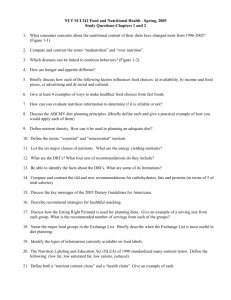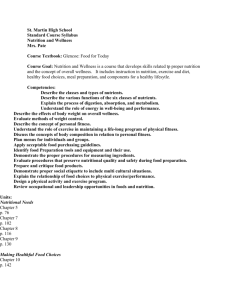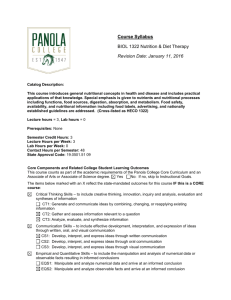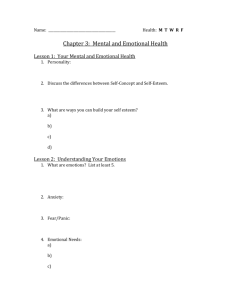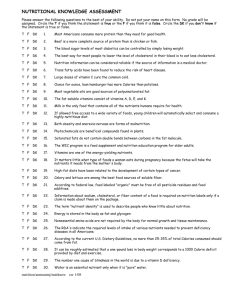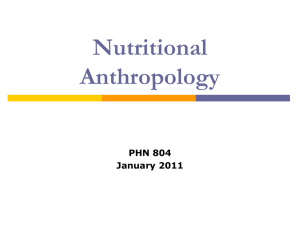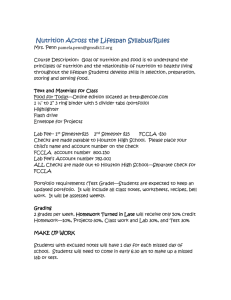Lifespan- Independent Research Unit
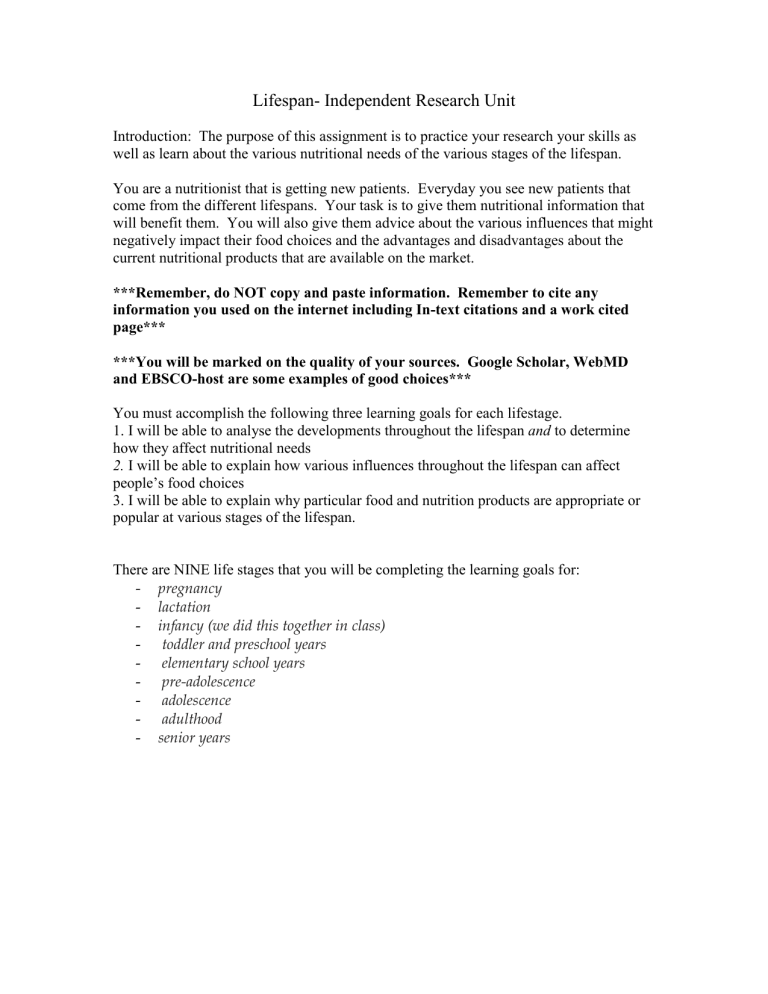
Lifespan- Independent Research Unit
Introduction: The purpose of this assignment is to practice your research your skills as well as learn about the various nutritional needs of the various stages of the lifespan.
You are a nutritionist that is getting new patients. Everyday you see new patients that come from the different lifespans. Your task is to give them nutritional information that will benefit them. You will also give them advice about the various influences that might negatively impact their food choices and the advantages and disadvantages about the current nutritional products that are available on the market.
***Remember, do NOT copy and paste information. Remember to cite any information you used on the internet including In-text citations and a work cited page***
***You will be marked on the quality of your sources. Google Scholar, WebMD and EBSCO-host are some examples of good choices***
You must accomplish the following three learning goals for each lifestage.
1. I will be able to analyse the developments throughout the lifespan and to determine how they affect nutritional needs
2. I will be able to explain how various influences throughout the lifespan can affect people’s food choices
3. I will be able to explain why particular food and nutrition products are appropriate or popular at various stages of the lifespan.
There are NINE life stages that you will be completing the learning goals for:
pregnancy
lactation
infancy (we did this together in class)
toddler and preschool years
elementary school years
pre-adolescence
adolescence
adulthood
senior years
Pregnancy
A woman comes into your office and explains that she is pregnant and is looking for nutritional information to help the baby grow.
1.
What diet would you recommend for your patient?
2.
Find 1 article from an academic resource to support your recommendations.
(make sure you cite your resource)
3.
Summarize the article you found into 5 sentences
4.
What general healthy lifestyle advice would you give your patient?
5.
Choose two influences that might affect what your patient eats and the food choices they make?
6.
What products are available on the market can help with the nutrition of pregnant women?
Lactation/Breast-Feeding (0 – 6 months)
1.
Read the following article and summarize each subheading. (this article is 4 pages long) http://www.nutritionmd.org/nutrition_tips/nutrition_tips_pregnancy_nutrition/lact ation.html
2.
What is one influence that you think might change the way a lactating mother makes food choices?
3.
What is healthier, breast-feeding or formula? (be sure to find research to support your opinion)
4.
Why would it be harder to breast-feed your child as a working mother?
5.
What products are available to help a breast-feeding mother ensure her baby is receiving enough nutrients?
6.
With a partner, create a product for nursing mothers that would help them to ensure her baby is getting enough of the nutrients needed to keep them healthy and strong.
Toddler and Pre-School Years (2-4 years old)
1.
In partners, develop a newsletter aimed at parents of preschool school children, explaining to them the importance of developing healthy food habits and eating practices in their children. In your newsletter include the following: a.
Influences on a young child’s food habits b.
Risk factors of unhealthy eating habits c.
A list of things parents can do to encourage healthy eating practices d.
Additional nutrients that Toddlers and Pre-school aged children need.
2.
What products are available to help parents of preschool school children to ensure their child is receiving enough nutrients?
Elementary School (5-8 years old)
1.
When children begin school their diet often changes. Ask your parent/guardian if the food that you ate changed when you started to go to school. Why or why not?
2.
What could be a healthy lunch that you could pack your child going to school?
You need two snacks, a drink and a lunch. (Remember Canada’s Food Guide)
3.
What is the Elementary School Nutrition Services? What are the advantages and disadvantages of this service? http://www.therecord.com/shopping-story/4223564-elementary-school-nutrition-services/
4.
Research: Explain the government legislation on the New Food and Beverage
Policy in Canadian schools. Information is found on the below websites. http://www.edu.gov.on.ca/eng/healthyschools/policy.html
http://www.edu.gov.on.ca/extra/eng/ppm/150.html
http://www.edu.gov.on.ca/eng/healthyschools/PPM150_Resource_Guide_2010.pdf
Pre-Adolescence (9-13 years old)
1. All questions are based on the following study: http://www.ncbi.nlm.nih.gov/pmc/articles/PMC3249260/ a) What was the purpose of the study? b) Who were the study subjects? c) What information did the researchers look at in the children? d) In the discussion section of the study, what was the conclusion that the researchers came to? e) What were some of the reasons that the scientists said led to childhood obesity?
2.
(not in the case study) What are some ways that pre-adolescence can maintain a healthy weight? This information should be based on research.
3.
Explain what nutrients pre-adolescence need an increased amount of. This should also be based on research.
Adolescence (14-18 years)
1.
Create a 10 questions research survey to poll your peers addressing nutrition related problems in your age group. You must survey at least 10 people. a.
You must create a focus for your questionnaire. (what topic do you hope to get more information about?) b.
Summarize your findings. c.
Draw a conclusion about the results of your questionnaire.
2.
Why might conflict develop in some families when the teens adopt different eating patterns than the parents?
3.
What specific foods are currently being marketed to appeal to teenagers?
4.
How do you think your friends influence your food choices? OR how do you influence your friends food choices?
Adulthood (19-55 years old)
1.
What are some specific nutritional needs associated with adulthood? (this should be research based)
2.
How can these needs be addressed with proper food choices?
3.
How do food choices related to candy, beverages, or vegetables reflect an individual’s self-identity at any given time in the person’s development?
4.
What are some factors that influence adults’ food choices?
5.
Why is it difficult for adults to eat a healthy diet?
6.
What food products are being marketed towards adults to help them to lose weight?
7.
If an adult wanted to life a healthy lifestyle, what would you recommend? (this should be research based)
8.
Primary Research: Interview 2 adults on their food choices. a.
You must ask a minimum of 5 questions b.
Explanation of who you interviewed and why. c.
You must write a 1 paragraph conclusion about the interview.
Aging Adults (56-70 years old)
1.
What specific foods are currently being marketed to appeal to the elderly?
2.
What are some factors that might influence the food choices the elderly make?
3.
What are nutrients that aging adults might be missing in their diet? ( this should be research based)
4.
Using a graphic organizer, compare and contrast the nutrition needs of aging adults to adults.
5.
Answers are based on the PubMed abstract in the following link: http://www.ncbi.nlm.nih.gov/pubmed/7486469 a.
What are the most common nutrition problems in nursing homes? b.
What causes weight loss in nursing home patients? c.
Why is having a vitamin deficiency a problem in nursing home patients? d.
What are some suggestions you could give to help solve the problems associated with living in a nursing home?
